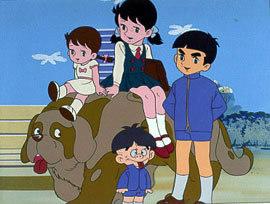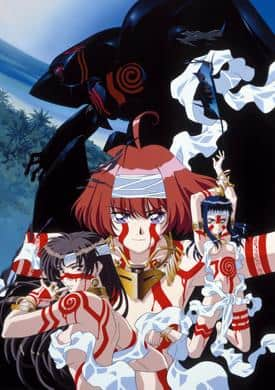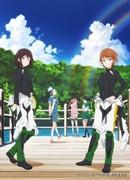The appeal and reviews of "Akane-chan": A moving story and deep characters

Akane-chan - Akane-chan■ Public MediaTV anime series ■ Original Mediacomics ■ Broadcast period April 6, 1968 - September 29, 1968 Every Saturday 19:00-19:30 ■Broadcasting stationFuji Television ■Frequencieshalf an hour ■ Number of EpisodesEpisode 26 ■Original StoryChiba Tetsuya ■ ProductionToei Animation ■Works©Tetsuya Chiba/Toei Animation ■ StoryAkane, a wild girl from the countryside, transfers to Shirakaba Gakuen, a prestigious school in the city. Although she behaves violently, to the point that her siblings are astonished, Akane is innocent and has a kind heart for others, and she quickly becomes popular at school. She becomes friends with the rich and selfish Hidemaro, and the two solve various incidents that occur at school. ■ExplanationThis anime is based on "Misokkasu," a manga serialized in Kodansha's "Weekly Shonen Friend" magazine in 1966 by Chiba Tetsuya. When it was made into an anime, the title was changed to "Akane-chan" after the main character's name. Accordingly, the original manga was also renamed to "Akane-chan." ■CastAkane Kamijo/Minori Matsushima/Hidemaro Kitakoji/Kazue Takahashi/Hanako/Nana Yamaguchi/Sakura/Kazuko Sugiyama/Dad/Toshiya Ogata/Mom/Haruko Yajima/Uncle Kusasuke/Kunihiko Kitagawa/Chairman Kitakoji/Koichi Tomita/Principal/Miyoko Aso/Tsuda Sensei/Ichiro Nagai/Tokugawa-kun/Osamu Ichikawa/Konoe-kun/Shun Yashiro ■ Main staff・Original story by Tetsuya Chiba・Planning by Daisaku Shirakawa, Katsuyuki Onuma, Yoshiyuki Shindo・Production by Masaharu Eto・Direction by Bonjin Nagaki, Yasuo Yamaguchi, Tokushige Shirane, Takeshi Tamiya, and others・Screenplay by Shunichi Yukimuro, Tadaaki Yamazaki, Masaki Tsuji, Toyohiro Ando, and others・Character design by Shinya Takahashi・Illustration by Kenzo Koizumi, Shinya Takahashi, Michimasa Ochiai, Noriyuki Kubo, and others・Art by Saburo Yokoi, Shigeyoshi Endo, Hideo Chiba・Music by Keiichi Awano ■ Main Characters Akane Kamijou The third daughter of the prestigious Kamijou family. Due to poor health, she was taken in by her uncle and lived in the countryside. ■Subtitle Episode 1: Misokkasu has arrivedEpisode 2: Akare and HidebaroEpisode 3: Go ahead!! MisokkasuEpisode 4: Don't die, ChibiEpisode 5: Hello Mr. GoatEpisode 6: Apparacha PompoonEpisode 7: Kanna is crying tooEpisode 8: Hidebaro tries his bestEpisode 9: Finger-cutting GenmanEpisode 10: Is the ramen sweet or saltyEpisode 11: You're deadEpisode 12: Akane flies in the sky ■ Theme songs and music・Theme song/OP "Akane-chan" Akane-chan - Akane-chan Reviews and RecommendationsAkane-chan, which aired in 1968, is an anime based on Chiba Tetsuya's original manga Misokkasu, and was very popular among children at the time. The main character, Kamijo Akane (Akane-chan), is a wild child who transfers from the countryside to the prestigious Shirakaba Academy in the city, but she is portrayed as a character with innocence and kindness. Her exploits, friendships at school, and the resolution of various cases provided viewers with many moving moments and laughs. This work is one of the anime that symbolizes the Showa era, and I would like to take this opportunity to look back on its appeal and value. Story and CharactersThe story of "Akane-chan" is about Akane-chan, who transfers to a prestigious school in the city and solves various incidents that occur at the school. Her innocence and kindness make many friends at the school, and her friendship with Hidemaro, who is selfish and a little bit stupid, in particular, deeply moved viewers. Akane-chan's character was an ideal friend for children at the time, and many things could be learned from her actions and words. Furthermore, her relationship with Hidemaro is not just one of friendship, but also depicts the process of their mutual growth, deeply moving viewers. Akane's innocence and kindness, and Hidemaro's selfishness and growth, provided many viewers with inspiration and laughter. Animation and MusicThe animation for "Akane-chan" was produced using Toei Animation's technical capabilities, providing vivid images for children at the time. The character designs were done by Shinya Takahashi, who skillfully expressed the individuality of each character. In addition, the drawings were done by top animators of the time, such as Kenzo Koizumi and Michimasa Ochiai, who helped to improve the quality of the work. In terms of music, the theme song "Akane-chan" and the ending song "Hidebaro Song", composed by Awano Keiichi, left a strong impression and left a deep impression on viewers. "Akane-chan" in particular, sung by Matsushima Minori, was loved as a song that gave viewers energy and courage. "Hidebaro Song", sung by Takahashi Kazue, was also loved as a song that symbolized the character of Hidemaro. Broadcast and influence"Akane-chan" was broadcast every Saturday from 7:00 to 7:30 p.m. from April 6 to September 29, 1968, but the broadcast time was changed to every Sunday from 7:30 to 8:00 p.m. from July 7. The ratings were high during the 26 episode broadcast period, and it was very popular among children. The original manga was also renamed "Akane-chan" when it was made into an anime, and it gained even more readers. This work is one of the most iconic anime of the Showa era, and its influence was huge. Akane's innocence and kindness in particular deeply touched viewers, providing many children with the ideal friend. Also, through her friendship with Hidemaro and solving incidents at school, viewers were able to learn and grow in many ways. Recommendations and ratings"Akane-chan" is one of the anime that symbolizes the Showa era, and its charm and value have not faded even today. Akane-chan's innocence and kindness, and her friendship with Hidemaro, have deeply touched and humoured viewers, and taught them many things. The animation and music were also of high quality, providing viewers with vivid images and memorable songs. This work can be enjoyed by both children and adults, and is a must-see for those who are nostalgic for the Showa era. It will also be a good opportunity for children today to learn about Akane's innocence and kindness, and the importance of friendship. It is a work that everyone should definitely watch. Supplementary Information"Akane-chan" is based on the original manga "Misokkasu" by Chiba Tetsuya, which was serialized in Kodansha's "Weekly Shonen Friend" in 1966, and was renamed "Akane-chan" when it was made into an anime. The original manga focuses on the exploits of the main character Akane-chan, and the anime version retains that essence. The anime version also includes many original episodes that were not in the original manga, providing new appeal to viewers. In terms of the cast, the main character, Akane Kamijo, was played by Minori Matsushima, and Hidemaro was played by Kazue Takahashi. The performances of both actresses skillfully expressed the personalities of their characters, deeply moving the audience. The other cast members were also very unique, which raised the quality of the entire work. In terms of staff, the project included original author Chiba Tetsuya, planners Shirakawa Daisaku, Onuma Katsuyuki, and Shindo Yoshiyuki, producer Eto Masaharu, directors Nagaki Bonjin, Yamaguchi Yasuo, Shirane Tokushige, and Tamiya Takeshi, scriptwriters Yukimuro Shunichi, Yamazaki Tadaaki, Tsuji Masaki, and Ando Toyohiro, character designer Takahashi Shinya, animation directors Koizumi Kenzo, Takahashi Shinya, Ochiai Michimasa, and Kubo Noriyuki, art director Yokoi Saburo, Endo Shigeyoshi, and Chiba Hideo, and music director Awano Keiichi, all of whom were leading staff members at the time, and this helped to improve the quality of the work. The subtitles symbolized each of the 26 episodes, giving viewers a sense of what was to come. The theme song "Akane-chan" and the ending song "Hidebaro Song" were deeply engraved in the hearts of viewers, further enhancing the appeal of the series. Above is a summary of my review and recommendation of "Akane-chan." This work, which symbolizes the Showa era, still retains its charm and value to this day, and is definitely one that I would recommend you watch at least once. |
<<: The appeal and reviews of Kaibutsu-kun Season 1: Digging deeper into the world of monsters
>>: Cyborg 009 #3: A thorough review of the touching story and character depth
Recommend
Worthy of the Plastic Team! A master player made a Kamen Rider suit with cheap foam assembly pads
Handicraft masters always discover good things ar...
The Mandalorian and Gogu movie is moved up to May 22, 2026
The "Star Wars" spin-off movie "Th...
A Thorough Analysis of the Fascinating New Era Samurai Story
Hyakka Ryoran Samurai After - Hyakka Ryoran Samur...
Robert Pattinson talks about why he wants to play the new "Batman": I want to present a newer and more modern Batman
Recently, Robert Pattinson shot the cover and a s...
Disney fires Marvel Entertainment chairman, plans to fire Kevin Feige
The New York Times reported today that Disney has...
Nanako Anatomy: Exploring the psychology of this fascinating character
Nanako Dissection Report - Nanako Kaitaishinsho -...
The latest stills and art pictures of the new theatrical version of the famous game "Alchemy for Whom" are still beautiful
The new animated theatrical version of "Alch...
Stardust poster of "The Wandering Earth 2" Human courage and perseverance will be forever engraved in the starry sky
Today (December 14), a new trailer for the movie ...
The collaboration movie between Glass Mask and Secret Society Eagle Talon turned out better than expected!
Glass Mask Z Secret Society Eagle Talon Collabora...
"Game of the Brave 2" first released Chinese trailer, all four main characters return
"Jumanji: The Next Level" released its ...
Ani×Para Episode 9 Boccia Review: Who is your hero?
Ani×Para~Who is your hero?~ Episode 9 "Bocci...
The appeal and reviews of "Yumeria": A moving film that transcends the boundaries between dreams and reality
"Yumeria" - A youth fantasy that unfold...
New Star Trek Movie in Production, Star Wars: Andor Director Directed
According to Deadline, JJ Abrams' company Bad...
Jackie Chan: I have been in the industry for 60 years and have worked hard for 60 years. I still want to continue
The action film "Vanguard" directed by ...
It's easy to make money. Bran in Game of Thrones makes $175,000 per episode for lying in a wheelchair and rolling his eyes
According to Variety magazine, Isaac Hempstead Wr...









